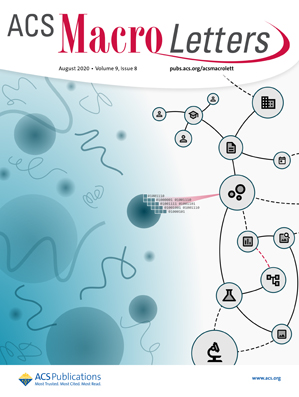Low-Bandgap Organic Conjugated Copolymers with Ultra-Broadband Optical Limiting Properties Extending to Near-Infrared-II.
IF 5.1
Q1 POLYMER SCIENCE
引用次数: 0
Abstract
Developing organic conjugated copolymers with an intramolecular charge transfer (ICT) system is an efficient strategy for expanding their applications but is still a challenge for broadband optical limiting (OL). Herein, three thiadiazoloquinoxaline (TQ)-based donor-acceptor (D-A) type copolymers P1, P2, and P3 with different electron-donating groups of thiophene, bithiophene, and di(thiophen-2-yl)ethene, respectively, were reported. Copolymers exhibit low bandgaps of 0.70-0.83 eV attributed to their extended π-conjugation and strong ICT. Interestingly, these copolymers display the nonlinear optical response of reversed saturable absorption (RSA) extending from the visible to near-infrared-II region. P3 exhibits the most excellent RSA property with a nonlinear absorption coefficient (β) value of 17.8 cm GW-1, over double that of P1 and P2. Consequently, P3 displays the most remarkable OL ability with a limiting threshold (Fth) of 8.9 J cm-2 under a laser wavelength of 1600 nm. This study provides a new strategy for developing ultra-broadband OL materials based on well-identified D-A copolymers.低带隙有机共轭共聚物的超宽带光学限制性能扩展到近红外ii。
开发具有分子内电荷转移(ICT)系统的有机共轭共聚物是扩大其应用的有效策略,但对于宽带光限制(OL)来说仍然是一个挑战。本文报道了三种以噻二唑喹啉(TQ)为基础的给受体(D-A)型共聚物P1、P2和P3,它们分别含有噻吩、二噻吩-2-基)乙烯的不同给电子基团。共聚物具有较宽的π共轭和较强的ICT,具有0.70 ~ 0.83 eV的低带隙。有趣的是,这些共聚物显示出从可见光区到近红外区反向饱和吸收(RSA)的非线性光学响应。P3的非线性吸收系数(β)值为17.8 cm gw1,是P1和P2的两倍多,具有最优异的RSA特性。因此,在1600 nm激光波长下,P3表现出最显著的OL能力,极限阈值(Fth)为8.9 J cm-2。该研究为基于已确定的D-A共聚物开发超宽带OL材料提供了新的策略。
本文章由计算机程序翻译,如有差异,请以英文原文为准。
求助全文
约1分钟内获得全文
求助全文
来源期刊
CiteScore
10.40
自引率
3.40%
发文量
209
审稿时长
1 months
期刊介绍:
ACS Macro Letters publishes research in all areas of contemporary soft matter science in which macromolecules play a key role, including nanotechnology, self-assembly, supramolecular chemistry, biomaterials, energy generation and storage, and renewable/sustainable materials. Submissions to ACS Macro Letters should justify clearly the rapid disclosure of the key elements of the study. The scope of the journal includes high-impact research of broad interest in all areas of polymer science and engineering, including cross-disciplinary research that interfaces with polymer science.
With the launch of ACS Macro Letters, all Communications that were formerly published in Macromolecules and Biomacromolecules will be published as Letters in ACS Macro Letters.

 求助内容:
求助内容: 应助结果提醒方式:
应助结果提醒方式:


